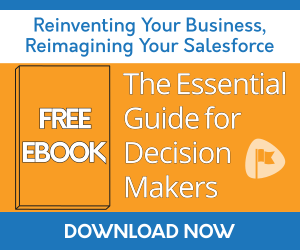How Decision Makers Can Confidently Enact Successful Strategic Change
2021/11/12

As businesses continue to react to the new challenges imposed on a world still reeling from a pandemic in its second year, this truth has emerged: Waiting to undertake strategic business transformation is not an option.
Instilling Confidence
It would be nice if businesses could wait until the turmoil is over, gain a full understanding of the new environment, and then confidently make the changes needed to succeed. However, time is a luxury most businesses can’t afford. Business leaders need to move forward and enact transformation now, even if they may not have all the information they desire.
In another post on this blog, we recounted how Sales Leaders are grappling with a new type of buyer and buyer’s journey. Sales teams need to take a calculated and analytical approach to understand how to proceed, but that type of approach is not only limited to the sales function of a business. Salesforce’s “State of Commerce” report, first edition, also highlights the rapid changes for B2B and B2C businesses.
Opportunities for strategic change are found in every part of a business. And while waiting is not an option, businesses can’t do everything they want to undertake all at the same time. Decision Makers also need to take a calculated and analytical approach, taking advantage of tools that increase the odds of getting it right. Only then can they have the confidence required to make important decisions, prioritize activities, and get the buy-in needed for success.
Removing Undue Influences & Biases
During the entire process of strategic change—data discovery, decision making, action planning and prioritization—leaders work hard to remove faulty data from considerations. The worst case scenario is making high-impact judgments based on information believed to be sound, but actually was bad or incomplete.
In addition, when it comes to seeking sound data, some data is more important than others: Not all data is created equal. The good news is that data can be more easily analyzed objectively than other inputs to setting strategic direction.
Every person brings bias to their decision-making process—and it’s not all bad. Previous experience is a type of bias that can supplement data and may help get to a better outcome. Of course, negative forms of bias can be equally unhelpful. Meanwhile, other kinds of individual bias may go completely undetected, but will still affect decision making and prioritization.
It is said that there is strength in numbers as well as wisdom in crowds. This can be true when looking to limit individual biases. On the other hand, group biases also exist, positively and negatively. Ultimately, given all the variables, Decision Makers need to use proven methods to understand the impact of both undue influences on data and biases from people (including their own biases).
Decision Making Occurs at Every Level of the Business
While leadership-level decision making is the most visible form and considered to have the highest impact, there are decisions being made everyday throughout an organization—and they are important in their own way. A prime example is the hiring process. Many subjective factors may go into deciding which people will fulfill roles in the organization. Those factors should be properly understood and controlled.
Further, strategic transformation only works when the people actually executing it day-to-day have achieved buy-in and are making the right decisions to support the vision and mission. Certainly, these lower-level Decision Makers are susceptible to the same issues previously discussed for leaders. However, there is likely not the same support system for addressing those issues.
When “culture eats strategy for lunch,” a culture that employs a calculated and analytical approach to decision making and prioritization at all levels goes a long way toward achieving business goals. If leadership can be transparent about the efforts expended to reach the right conclusions about strategic transformation, then the organization will find it easier to follow their lead and execute.
The Essential Guide for Decision Makers
Business transformation and leading change can be difficult. To help, Passage Technology developed a series of e-Books under the theme of Reinventing Your Business, Reimagining Your Salesforce. These Essential Guides for Business Transformation are free to download. (Check out our blog post, “Getting Essential Guidance to Innovate, Adapt, and Thrive,” for additional info on the entire series.)
One of the e-Books, The Essential Guide for Decision Makers, offers insights on how to extend the capabilities of the Salesforce platform to assist with all types of decision making and prioritization. With the right data at their fingertips, combined with a calculated and analytical approach, Decision Makers are in a better position to improve performance and outcomes throughout the enterprise.
In these challenging times, getting more out of Salesforce can help take a business to the next level. Get your free Guide today.
| Get Answers to Your Frequently Asked Questions About Our Apps | Passage Technology Blog | Brightening the Holidays for Hospitalized Kids with Handmade Cards |
